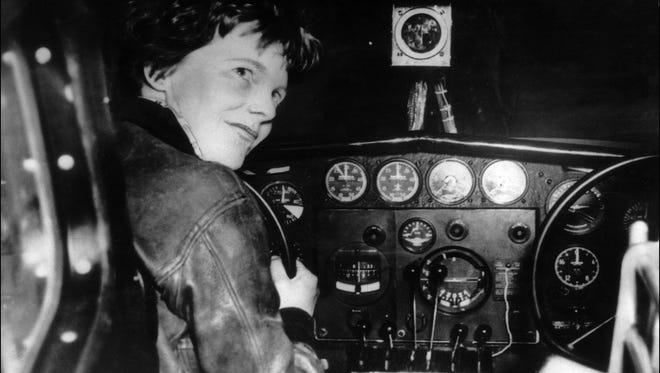Was Amelia Earhart captured by the Japanese? 4 theories about her disappearance

Editor's note: This story from 2016 has been updated with new information.
Amelia Earhart wanted to become the first woman to fly around the world. Instead, her plane vanished on July 2, 1937.
Although decades have passed since her last radio call on July 2, 1937, the mystery of her disappearance has captivated the minds of many. After she vanished, the United States government conducted its largest ever search for a lost aircraft, but turned up empty-handed.
Today the search continues. A team of researchers recently used bone-sniffing dogs in hopes of finding her remains on a remote Pacific island, where they believe she may have died as a castaway.
But the castaway theory is far from the only theory surrounding her demise.
Ric Gillespie, executive director of The International Group for Historic Aircraft Recovery (TIGHAR), said there are four theories about what happened to Earhart:
1. Earhart ran out of gas and crashed into the sea somewhere near Howland Island in the Pacific Ocean.
According to Gillespie, this verdict was widely accepted by the U.S. Government after a tireless search for Earhart in the midst of the Great Depression came up empty.
“It’s the intuitive explanation,” he said. “They looked at everything and didn’t find anything, so they thought she must have sunk at sea.”
2. She was captured by the Japanese.
A photograph recently discovered in the U.S. National Archives may add weight to the theory that Earhart survived a landing in the Marshall Islands and was taken captive by the Japanese.
The grainy photo shows a picture of a woman with short hair and a man that looks like her co-pilot, Fred Noonan, after their crash, according to a History Channel special dubbed Amelia Earhart: The Lost Evidence.
The show, which airs on Sunday, highlights additional evidence, including plane parts found on the Marshall Islands that appear to be like those on the plane Earhart flew in 1937, and an eyewitness who claims to have seen Earhart and Noonan after they supposedly perished.
Japanese authorities told NBC that there are no records indicating that Earhart was in Japanese custody.
Gillespie said another popular theory that popped up shortly after Earhart’s disappearance was that she was on a covert spy mission for the Roosevelt administration and was taking photographs in the Pacific to see whether the Japanese were fortifying the Marshall Islands, Gillespie said.
New evidence could prove that Amelia Earhart died as a castaway
He said some believe she was captured and died in custody.

3. She died as a castaway on a remote island.
Earhart was flying towards Howland Island in the Pacific, but was running low on gas before she vanished. Her final in-flight radio message occurred around 08:43 local time.
“We are on the line 157 337. We will repeat this message. We will repeat this on 6210 kilocycles. Wait,” she said.
Gillespie said TIGHAR believes Earhart actually landed on Gardner Island, which is also known as Nikumaroro.
According to Gillespie, radio logs show that Earhart used the aircraft’s radio to make distress calls for help several days after landing.
In 1940, skeletal remains were found on the island, and Gillespie believes they could belong to Earhart.
According to TIGHAR, the bones were analyzed in 1940, but a doctor concluded they belonged to a male and the bones were later lost.
In 1998, TIGHAR discovered files about the remains, including skeletal measurements, and researchers determined the bones were consistent with a female of Earhart’s height.
Anthropologist Richard Jantz recently noticed that the skeleton’s forearms were larger than normal, but Jantz was unable to decipher whether Earhart’s arms were similar in length, according to the group.
In order to compare the length of the Earhart's forearms with those of the remains, TIGHAR asked forensic examiner Jeff Glickman for help.
Glickman said he was able to determine Earhart’s forearm length by examining a historical photograph where at least one of her arms is largely visible.
He found that Earhart’s “humerus to radius ratio was 0.76 – virtually identical to the castaway’s,” TIGHAR said in a statement.
TIGHAR recently used bone-sniffing dogs in hopes of finding Earhart's remains on the island, but the search came up empty-handed.
TIGHAR hoped the bones could prove whether the castaway theory was correct once and for all.
"Her story is a wonderful story of survival and heroism that has a tragic end and her last chapter needs to be known," Gillespie said. "We need to get all the information we can to write that last chapter so we will keep going as long as we can."
More coverage:
Bone-sniffing dogs will search for Amelia Earhart's remains on remote island
New photo may prove Amelia Earhart was captured by the Japanese
Was Amelia Earhart a New Jersey housewife?
4. She returned to the U.S. and lived her life as a N.J. housewife
One of the many theories over the years about what happened to Earhart was that she returned to the United States and was a housewife in New Jersey.
In the 1970s, a book called Amelia Earhart Lives by Joe Klass was published, claiming that Irene Bolam, a woman living in Monroe Township, N.J., in Middlesex County, was the lost pilot.
Someone saw Bolam at a garden party in New York's Long Island and thought her to be Earhart, Richard Gillespie told The (Bergen County, N.Y.) Record in another interview. Bolam denied she was the female aviator, but Klass' book claimed that Earhart returned to the United States after World War II to live a different life as a New Jersey housewife. Bolam, who bore a slight resemblance to Earhart, also was a pilot.
Bolam sued Klass and McGraw-Hill after the book was published and received a settlement of an unknown amount. The publisher pulled the books from the shelves.
"People will believe anything," said Gillespie.

Contributing: Kaitlyn Kanzler, The (Bergen County, N.Y.) Record
Follow @MaryBowerman on Twitter.